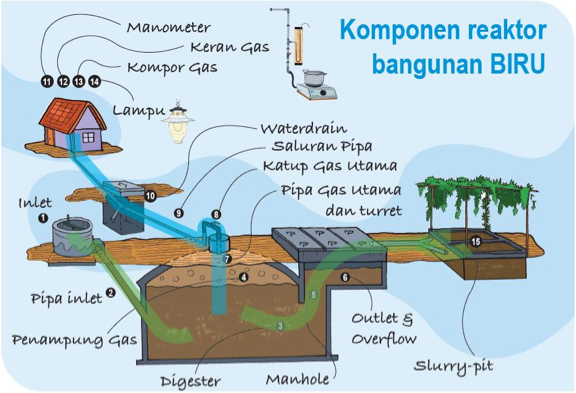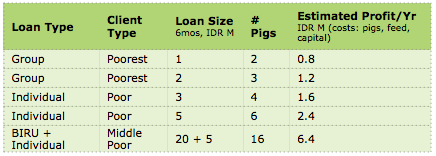Green Microfinance: Backyard Biogas in Bali, Indonesia
July 28, 2011
By Anne Conlin, KF15, Indonesia
In a past blog post, I discussed how loans from Kiva’s partner Mitra Usaha Kecil (MUK) in rural West Bali, Indonesia are helping women expand the scale of their pig breeding businesses. MUK’s Pig Breeder Group Loan enables women who have long casually raised one pig in their yard to take small loans of 1 – 2.5M IDR ($117 – $263) to formalize their business and raise additional pigs. As part of MUK’s mission statement is to address local environmental issues, MUK is currently piloting a program that would put pig waste to good use, by installing biogas digesters in the backyards of some successful pig borrowers.
MUK’s biogas pilot program is called BIRU, short for Biogas Rumah (house in Bahasa Indonesian) and is funded by the Dutch government in partnership with the Indonesian Ministry of Energy. BIRU was motivated by the role of energy in the Millennium Development Goals and has set a goal of 8,000 installed units by the end of 2012. The Dutch government has dedicated $1M to establishing a “market-oriented, feasible and self-reliant biogas sector” in Indonesia. To make the systems more affordable, BIRU has trained masons to construct the systems efficiently and has partnered with several banks and MFIs – including MUK – to finance construction.
How the BIRU system works:
The pig breeder puts pig waste into a cement inlet and mixes with water in a 1:2 ratio.
The mixture flows into the digester, an eight cubic meter underground cement box with a domed roof. The slurry is mixed every day via the manhole and allowed to ferment for several days.
After fermentation, the gas rises to the top of the domed digester and flows through a pipe into the house where it is connected to a special stove. If all goes well, the household will be able to run their stove without any other sources of fuel. If all goes really well – and if the house has a lot of pigs – they should also be able to run their lights. The important question: how much does this all cost? The fully installed cost is 7M IDR, but the Dutch government has offered a 2M IDR subsidy bringing the cost to the client to 5M IDR ($590).
At first glance, BIRU seems like a winning situation for all sides: MUK can make a loan to fund construction of the digester, the households benefit from reduced energy costs, and the whole system serves an environmental mission. The economics of BIRU are a little more challenging.
BIRU can appeal to borrowers in many ways. Even in a country where the government subsidizes fuel, energy costs are a significant contributor to poor households’ budgets. Most MUK borrowers spend at least 100K IDR ($12) monthly on LPG fuel for their homes, before factoring in electricity costs, which can be another 80K IDR. A perfectly functioning BIRU system could therefore replace up to 180K per month in energy costs. (In the first MUK pilot house, the stove is functional but electricity costs have not yet been offset.) Additionally, the digester’s byproduct – Bio Slurry – is a potent organic fertilizer which may be more effective than chemical fertilizer. If the household saves roughly 200K per month on LPG, electricity, and fertilizer, cost savings would allow breakeven in 25 months.
Additionally, there are non-economic benefits of the BIRU system. Of course, the natural fertilizer produced is safer and better for the environment. Less apparent but still attractive are the benefits to the family’s health: fully-fermented pig waste and the Bio Slurry fertilizer are odorless and don’t attract flies, making BIRU more hygienic – and less stinky – than other methods for disposing of pig waste. Keeping in mind that most pigs in Bali live within a few yards of the home, this benefit increases exponentially for households with more than a few pigs. Though most MUK clients already cook with gas, biogas is generally lauded for providing an economical alternative to wood or charcoal fires for cooking, yielding reduced respiratory and eye problems for women.
Beyond the advantages related to health and cost-savings, the BIRU system goes hand-in-hand with larger-scale pig breeding, which has potential to facilitate a massive step-jump in familial income. MUK estimates that the BIRU system will require 16 pigs to be continuously functional. Annual profit from a pig breeding business of this scale is estimated at around 6.4M IDR or $750/year. MUK estimates that 90% of its clients live on less than $1.25/person/day, or about $1,825/yr for a family of four (much less than Bali’s per capita GDP of $1,670). So, an additional $750 per year represents a huge increase in household income, enough to theoretically move borrowers into the “middle poor” category.
Stepping a pig breeding business to this level of income requires a significant infusion of working capital. MUK’s biogas pilot program includes 25M in loans: a 5M loan for the BIRU system plus a 20M working capital loan to finance a 16-pig business ($2,900 total). The largest loan available through the Pig Breeder group is 2.5M, which generally enables borrowers to raise 3-4 pigs. Successful borrowers who want to continue expanding their business can get individual pig breeder loans of 5M IDR, with which borrowers generally raise 6 pigs. The BIRU loan package would represent a large increase over a previous loan for most borrowers, and a large loan relative to current income.
Given the vast difference between the scale of the BIRU loan product and MUK’s other loan products, targeting this program to the appropriate clients will be crucial. MUK has stipulated that clients must have successfully completed five to ten loan cycles to be eligible, but previous MUK Pig Group clients may not be appropriate targets given the income levels of even the most successful Pig Group borrowers. MUK estimates that only 2% of clients will be candidates for this loan, and they have identified and approached 100 such clients. MUK plans to appropriately target this product to clients who will be able to repay such a large loan to avoid over-indebtedness.
Ultimately, I think that BIRU is a tremendously exciting idea. I commend MUK management for being creative and taking risks and forming partnerships with international organizations to truly act on their mission statement of environmental benefit. MUK management is already anticipating some of the implementation challenges they may face. The BIRU program requires a great deal of foresight from borrowers. It asks that clients accept a breakeven several years out on a non-productive investment. And, it requires that clients are willing to pay a premium for health and environmental benefits. Having worked alongside MUK management during my fellowship, I am confident that they will take the necessary steps to educate their community on the potential benefits of BIRU and target the program to customers most able to benefit.
To learn more about Mitra Usaha Kecil, please visit MUK’s Kiva Partner Page or join the MUK Lending Team.
PREVIOUS ARTICLE
Featured Volunteer: Ekaterina Sukhanova →NEXT ARTICLE
Microfinance Notes: 25 July 2011 →


















